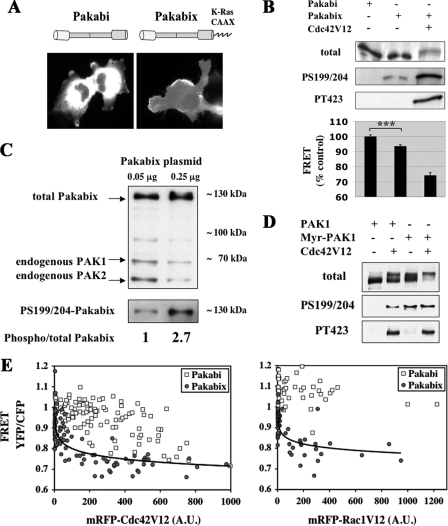FIGURE 2.
Effects of membrane recruitment on PAK1. A, cellular localization of Pakabi and Pakabix. Representative CFP images of COS-7 cells transfected with Pakabi and Pakabix are shown. B, phosphorylations and conformational changes of membrane-targeted Pakabix. Cells were transfected with vectors expressing Pakabi, Pakabix, and Cdc42V12 as indicated and analyzed as in Fig. 1B. Pakabi, n = 56; Pakabix, n = 51; Pakabix+Cdc42V12, n = 17. The difference between Pakabi and Pakabix was statistically very significant according to Student's t test (***, p < 0.0001). C, phosphorylation level of serines 199/204 is dependent on the cellular concentration of Pakabix. COS-7 cells were transfected with two different amounts of Pakabix vector (0.05 μg and 0.25 μg in 6-well dishes). Total lysates were normalized to load on the gel approximately equal amounts of Pakabix. Upper part, Western blot with anti-PAK antibody recognizing overexpressed Pakabix as well as endogenous PAK1 and PAK2. Lower part, Western blot with anti-phospho-PAK1-S199/204. Band intensities were measured with ImageJ; the ratio phosphorylated/total Pakabix was calculated for each transfection condition and normalized to the condition with the lowest amount of Pakabix plasmid transfected. D, phosphorylation of full-length PAK1, not fused to YFP/CFP. Cells were transfected with vectors expressing PAK1 (HA tagged at the C terminus) or Src-PAK1 (HA-tagged, with the myristoylation signal from v-Src at its N terminus) in the presence or absence of Cdc42V12. Total cell lysates were analyzed by Western blotting as indicated. Note the phosphorylation-dependent band shift of total PAK1. E, membrane PAK1 is hypersensitive to stimulation by Cdc42V12 and Rac1V12. COS-7 cells were transfected with vectors encoding cytosolic Pakabi or membrane-targeted Pakabix together with plasmid expressing mRFP-Cdc42V12 or mRFP-Rac1V12. For each living cell, YFP, CFP, and RFP images were acquired. The curves for Pakabix were fitted with a logarithmic function (determination coefficient R2 = 0.62 for Cdc42V12 and R2 = 0.49 for Rac1V12), whereas no acceptable fit could accommodate the Pakabi data (Microsoft Excel and the free software Lab Fit Curve Fitting). Note that the same Pakabi with Cdc42V12 data were used in the Fig. 1C.

